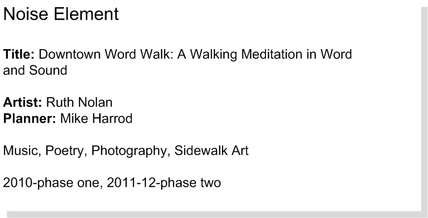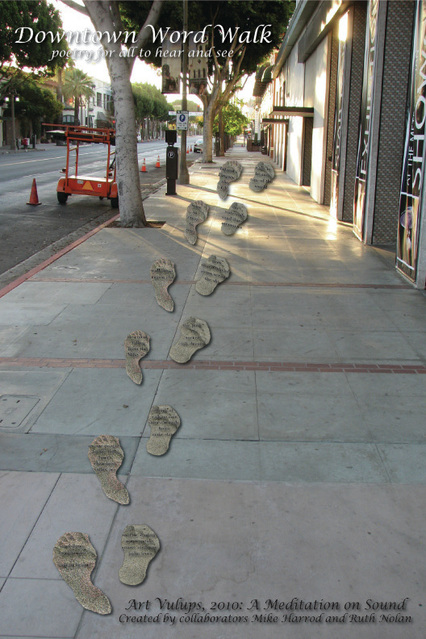About the workPoetry Walk
Under California state law, each city and county must prepare and adopt a comprehensive, long term, general plan “for the physical development of the county or city, and any land outside its boundaries which bears relation to its planning” (§65300). This document sets goals for the development of the community and establishes public policy relative to the distribution of future land uses, both public and private. The general plan must contain the seven mandated elements: land use, circulation, housing, conservation, open space, noise, and safety. Although planners work with these concepts, the public is usually unfamiliar with them. To convey these concepts to the public through art, this project paired an artist with a planner and assigned one of the elements of the general plan to serve as a starting point for the creation of a collaborative piece of art. In this case, a poet, Ruth Nolan, was paired with a retired planner, Michael Harrod. Their planning topic was noise. As the planner, it seemed appropriate for me to share the purpose of the noise element with the poet. Simply, the purpose of the noise element is to limit the exposure of the community to excessive noise levels. Moreover, it addresses: sources of noise in the community both existing noise and likely noise levels in the future due to development; the relationship of hospitals, schools, neighborhoods and other land to these noise sources; and includes policies to protect the public from excessive noise. Typical tools used by planners to reduce the ill effects of noise include soundproofing, landscaping and berms, building design and setbacks, buffer areas, and operating hours of major noise sources. Working with a poet made me choose my words more carefully, hopefully more poetically, but I will let Ruth be the judge. It also caused me to fundamentally reconsider the mental processes involved in my perception of noise. Some brain scientists define the mind as energy and information quite separate from the physical brain (Siegel). Physicists also describe sound as energy, waves of energy. Waves of energy crashing onto our ears would begin to describe noise. But as the brain scientists point out, our brain pulls information from this energy. The nature of this information and how we perceive it is what grab my interest about this project. The information in this energy tells us we are hearing a noisy freeway or an airplane overhead. How the noise affects us depends on its context as well. A jackhammer in a construction zone draws much less of our attention than a jackhammer in a church courtyard. When our minds are occupied with other thoughts, we may not even notice the ruckus around us. We must all learn to accept a certain level of noise when living and working in an urban environment. However, working with a poet made me realize that presenting poetry in an urban setting could transform our feelings and perceptions, blocking out the inevitable noise, and creating an enriching and rewarding experience. Poems placed on the sidewalks or walls could direct our focus inward or toward our companions and away from the inevitable noise of the city. Our discussions and reconsidering my own perceptions of noise were the origins of the poetry walk. I found our collaboration both inspiring and enjoyable and wish to thank Ruth for all her work. As a musician and a planner, I was also interested in the relationship between noise and music. Recently, I learned of a composer, Ryuichi Sakamoto, who, in his album, out of noise, wrestles with fundamental questions about what, is music and what is noise. According to Sakamoto, “As soon as you make a piano sound, it’s vanishing, vanishing into noise. You can’t tell when it becomes noise, when it’s gone. That’s the area I’m interested in.” Sakamoto goes on to say, “We are surrounded by the sound of the environment. That’s music too, really.” In summary, the poetry walk will create a mental sound barrier by shifting our attention towards the poetry on the sidewalk thereby dampening our perception of the noisy urban environment. Unlike a planner, whose designs physically block or separate the noise source from the listener, the poet’s walk will engage our spirit with beautiful words, free from noise. -Mike Harrod |
DOWNTOWN WORD WALK
|

